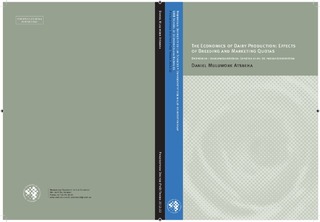| dc.contributor.advisor | Rickertsen, Kyrre | |
| dc.contributor.advisor | Kristofersson, Dadi | |
| dc.contributor.advisor | Nayga, Rodolfo Jr | |
| dc.contributor.author | Atsbeha, Daniel Muluwork | |
| dc.date.accessioned | 2018-05-08T08:35:52Z | |
| dc.date.available | 2018-05-08T08:35:52Z | |
| dc.date.issued | 2012 | |
| dc.identifier.isbn | 978-82-575-1024-4 | |
| dc.identifier.issn | 1503-1667 | |
| dc.identifier.uri | http://hdl.handle.net/11250/2497493 | |
| dc.description.abstract | This dissertation compiles four articles investigating the effects of breeding and marketing quota in dairy production. Farm level panel datasets from Norway and Iceland were used for the analysis. In the first article, the main objective was to measure the contribution of animal breeding to productivity growth on Icelandic dairy farms. An extended decomposition of the Malmquist productivity index was proposed for the task. Average productivity growth during 1997–2006 was 1.6%. Scale effects contributed the most followed by breeding, which contributed about 19% of the growth. The second article investigated the effects of broad breeding goals on production cost of dairy farms in Norway. A cost system allowing for unobserved heterogeneity was used to derive cost effects of genetic progress. Results show that genetic progress in welfare-improving traits such as health and fertility led to a 1% cumulative cost saving during 1999–2007. This corresponds to a perpetual industry-wide cost saving of NOK 160 million. The effect of Norwegian marketing quotas on milk quality, as measured by milk composition, was the objective of the third article. A theoretical model of substitution effects between milk quantity, as determined by each farm’s quota, and milk components was developed and empirically estimated. The substitution effect was positive for protein and negative for fat. Given the value of components, this suggests low milk quality as quota regimes get restrictive. The fourth article investigated supply response among Icelandic dairy farms under yield uncertainty and two-price system. An existing model of supply response that assumes single input in production was generalized to a multiple input setting. Results show milk supply response to a price change in quota milk market is only a third of the supply response to equivalent and simultaneous price change in quota and surplus milk markets. Finally, statistical testing preferred results from the generalized model. | nb_NO |
| dc.description.sponsorship | Tine BA ; the Agricultural Economics Institute of Iceland ; the Farmers Association of Iceland | nb_NO |
| dc.language.iso | eng | nb_NO |
| dc.publisher | Norwegian University of Life Sciences, Ås | nb_NO |
| dc.relation.ispartofseries | PhD Thesis;2012:22 | |
| dc.rights | Attribution-NonCommercial-NoDerivatives 4.0 Internasjonal | * |
| dc.rights.uri | http://creativecommons.org/licenses/by-nc-nd/4.0/deed.no | * |
| dc.title | The economics of dairy production : effects of breeding and marketing quotas | nb_NO |
| dc.title.alternative | Økonomien i melkeproduksjonen : effekter av avl og produksjonskvoter | nb_NO |
| dc.type | Doctoral thesis | nb_NO |
| dc.subject.nsi | VDP::Social science: 200::Economics: 210::Economics: 212 | nb_NO |
| dc.source.pagenumber | 204 | nb_NO |

